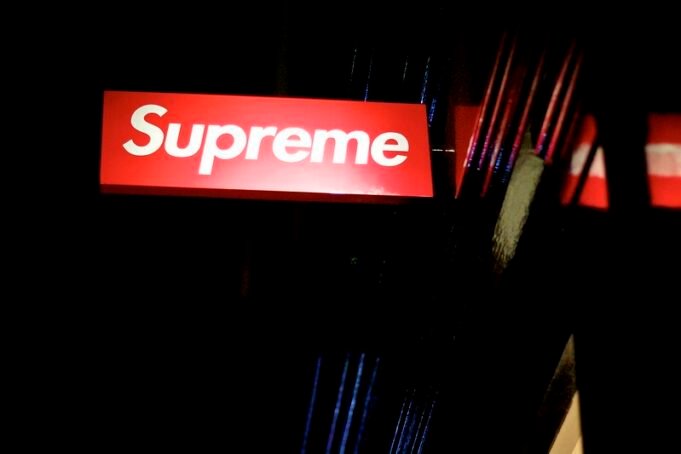The Supreme brand has cemented itself as one of the most iconic streetwear labels of all time. With its origins tracing back to 1994 in New York City, Supreme has risen from humble beginnings to become a cultural force in fashion. This article will explore the history of Supreme, its core values and appeal, the phenomenon of Supreme hype and resale, and the brand’s influence on streetwear and culture overall.
The Supreme logo, with its distinctive white font on a red box, is instantly recognizable worldwide. The brand has mastered the art of hype marketing and demand creation unlike any other. Through limited edition drops, savvy collaborations, and social media buzz, Supreme exerts an almost mythical allure amongst its devotees.
Part of Supreme’s appeal lies in its exclusivity. The scarcity of its products, from T-shirts to skateboard decks, fuels a constant scramble to cop the latest drop. This breeds an aura of underground authenticity that resonates with Supreme’s core demographic of youthful rebels and hypebeasts.
Beyond the hype, Supreme’s cultural impact stems from its skate roots and connections to New York hip-hop, punk, and street culture. Supreme clothing offers a way to tap into these vibrant subcultures. The brand has retained its outsider edge even while crossing over into the high fashion mainstream.
History of Supreme
Supreme was founded in 1994 by James Jebbia, an American entrepreneur with experience in streetwear retail. Jebbia opened the first Supreme store on Lafayette Street in downtown Manhattan, intending to create a space that blended elements of skateboarding, hip-hop, punk rock, and youth culture.
The name “Supreme” was chosen because Jebbia wanted the brand to represent the quintessential New York City skate shop. In an interview with Hypebeast, Jebbia stated: “The name came from the idea that whatever we were going to make would be the ‘supreme’ version of that product.”
In Supreme’s early days, Jebbia focused on basics like graphic T-shirts, hoodies, and skateboard decks. The clothing featured the Supreme logo prominently, establishing its signature look.
James Jebbia’s Vision
As founder of Supreme, James Jebbia sought to imbue the brand with an air of authenticity and exclusivity. Having worked for streetwear companies like Stussy, Jebbia was well-versed in youth culture and understood the appeal of underground brands.
Rather than chasing quick trends, Jebbia focused on quality. He collaborated with manufacturers to produce clothing and skateboard decks that stood out from standard offerings. The minimalist Supreme logo allowed the products to speak for themselves.
Jebbia also pioneered the idea of limited edition “drops” at Supreme. New products would be released in tight quantities, selling out quickly. This cultivated excitement around what Supreme would offer next, while preventing overexposure.
Early Collaborations and Streetwear Cred
In its formative years, Supreme formed partnerships with brands like Vans, Nike, and The North Face. These collaborations did wonders for boosting Supreme’s profile in the skating and streetwear communities.
The brand’s first sneaker collaboration came in 1996 with Vans. The two labels produced a custom style featuring the Supreme logo that became an instant hit. Supreme has partnered with Vans many times since, releasing exclusive sneakers that become impossible to find once they sell out.
Supreme’s first collaboration with The North Face came in 2007 and included a bold leather and printed nylon jacket. The fusion of Supreme’s streetwise sensibility with North Face’s technical outdoor gear was groundbreaking. It set the stage for future collabs between streetwear and high-end fashion brands.
Supreme’s Core Values and Appeal
Several factors underpin Supreme’s widespread appeal and hype. By sticking to core values like exclusivity, simplicity, and cultural relevance, the brand has retained an authentic edge that resonates with its devotees.
Limited-Edition Drops and Exclusivity
At the heart of Supreme’s success is its drop model of limited-edition product releases. Most items are only available in a single production run, which breeds urgency amongst shoppers to buy before stock sells out.
The difficulty of copping coveted pieces like Supreme’s Box Logo hoodies or collaborations with luxury brands enhances their value and prestige. This exclusivity sustains hype and gives Supreme drops the feel of cultural events.
Simplicity and Understated Branding
Supreme maintains a pared back, minimalist aesthetic in its products. Most pieces feature little branding beyond the Supreme name and logo. There are no flashy patterns or loud graphics.
This subtlety shifts focus onto quality. For devotees, wearing Supreme becomes about expressing brand knowledge and insider status rather than conspicuous logos. They recognize and appreciate the small details that Supreme puts into its goods.
Collabs and Cultural Relevance
Supreme constantly partners with other brands, artists, musicians, and celebrities to produce capsule collections and limited products. Recent collaborators include Louis Vuitton, Comme des Garçons, Nike, and Drake.
These collabs allow Supreme to stay relevant and fresh while connecting with different niches and demographics. Few other brands can pull off collaborations across both high fashion and streetwear authentically.
The Supreme Hype and Resale Market
The hype surrounding Supreme manifests itself most clearly on the resale market, where prices for rare pieces often skyrocket past retail value. Understanding the psychology behind Supreme’s consumer appeal provides insight into why its resale market is so active.
The Psychology of Hype
Supreme expertly engineers product scarcity and demand. By releasing limited batches of goods, Supreme creates a fear of missing out that drives consumers into a buying frenzy.
The difficulty of purchasing Supreme items also plays into people’s desire for exclusivity and status. Owning hard-to-find Supreme goods becomes a flex and a signifier of insider knowledge.
On a deeper level, Supreme’s anti-establishment ethos and connections to youth culture make it feel like an exclusive community. Consumers become emotionally invested in the brand.
Resale Market Phenomenon
Due to low stock and massive demand, Supreme products often sell out instantly online and in-store. This forces many fans to turn to the resale market if they miss out on drops.
Prices on resale sites like eBay, Grailed, and StockX routinely soar above retail value for rare or sold out Supreme items. It’s not unheard of for some pieces to resell for thousands of dollars.
These inflated resale prices demonstrate the scarcity that Supreme has manufactured. The brand releases just enough product to generate hype while deliberately underserving demand.
The Role of Social Media and Influencers
Modern hype culture is amplified through social media. Platforms like Instagram and Twitter act as word-of-mouth on steroids for Supreme’s drops and collabs.
Influencers also stoke demand by modeling Supreme’s latest gear for their millions of followers. Unboxing videos on YouTube further spread the hype. Supreme seeds product to prominent digital tastemakers to get items in front of the right eyeballs.
Supreme’s Impact on Fashion and Culture
Over the past three decades, Supreme has left an indelible mark on streetwear and influenced wider fashion and cultural trends. The brand exemplifies how an underground label can grow into a global phenomenon while retaining its authenticity.
Redefining Streetwear
In the ’90s and early 2000s, Supreme helped elevate streetwear from basic casual clothing into a serious fashion movement. The brand set a new bar for quality, style, and attention to detail in this category.
By blending skate and youth culture with high fashion collaborations, Supreme made streetwear into a form of cultural capital and identity. Its drops became can’t-miss events for style mavens.
Crossover Into High Fashion
Supreme demonstrated that streetwear brands could successfully collaborate with elite luxury labels as equals. Its partnerships blew up the old boundaries between high fashion and street style.
Luxury giants like Louis Vuitton and Gucci soon followed Supreme’s lead by partnering with other streetwear brands. This crossover pollination is now common in fashion but was quite radical when Supreme pioneered it.
Cultural Impact and Influence
Beyond fashion, Supreme has made its mark on wider popular culture. Its iconic red Box Logo has been referenced in songs, TV shows, and movies as a visual shorthand for street cred. The brand has also collaborated on projects with artists like Damien Hirst and Takashi Murakami.
For a certain breed of youthful iconoclasts, wearing Supreme expresses belonging to a cultural movement. At its core, the brand represents authenticity, exclusivity, and going against the mainstream.
Supreme’s Future Outlook
As Supreme looks ahead, the central challenge will be maintaining its elite status and connection to culture while continuing to expand. However, the brand has several factors working in its favor.
Maintaining Relevance and Authenticity
Supreme’s grip on the cutting edge may be the envy of the fashion world, but it will not last forever. Hype is inherently fickle. To retain its aura, Supreme must keep innovating and avoid becoming overexposed.
More collaborations with unique partners should help. So will limited capsule collections that capture the current cultural zeitgeist. Authenticity is Supreme’s core asset.
Navigating the Resale Market
Rather than fight the inflated resell market, Supreme can strategically leverage it. Very limited releases of special products will satisfy resellers while driving hype.
Letting prices climb on resale sites also reinforces Supreme’s prestige. The challenge is preventing the aftermarket from diluting the brand’s hard-earned exclusivity.
Expanding Beyond Streetwear
Streetwear now dominates fashion. As the category matures, Supreme will need to find new creative avenues for growth.
Expanding into lifestyle categories like homewares, luxury goods, and experiences offers potential. Supreme can also leverage collaborations to engage new demographics beyond its core male youth base. But this must be done judiciously to avoid compromising the brand’s essence.
Conclusion
For over 25 years, Supreme has built itself into one of the most significant brands in fashion through a mix of cultural authenticity, manufactured scarcity, and industry-defying collaborations.
By maintaining its outsider spirit even while ascending to the pinnacle of hype, Supreme has become the exemplar streetwear brand. It retains an aspirational quality that fuels incredible demand from consumers and imitators alike.
Yet Supreme’s biggest challenge still lies ahead: preserving its unique aura and reputation amidst an endless stream of newcomers aiming to claim its throne. However, if its history is any indicator, this brand will continue dictating the rhythm of the streets for the foreseeable future.




































